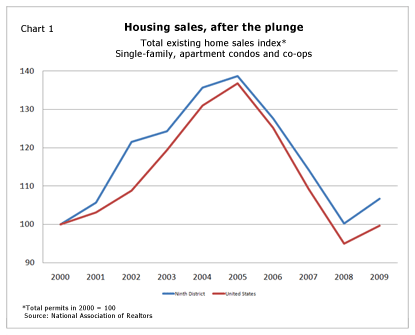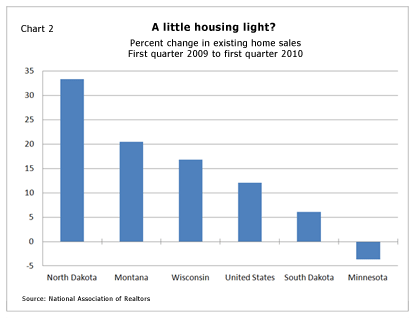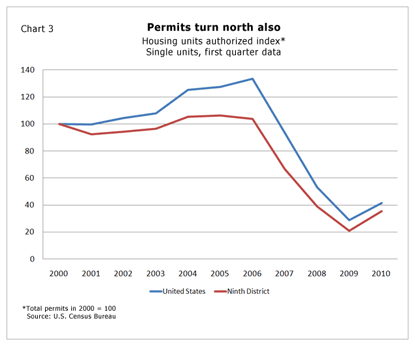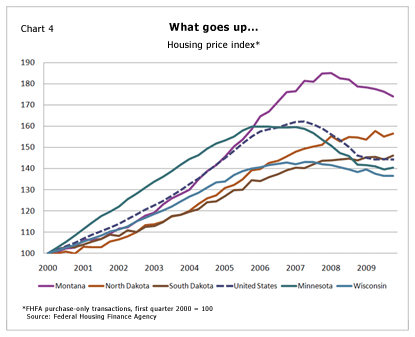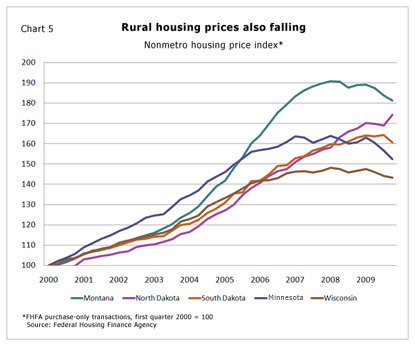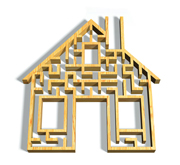
The past two years have been hard ones for the housing industry. Everyone is feeling for the bottom, hoping the sector’s frown turns upside down.
Recent data show some signs of life in the housing market, but it’s hard to say if actual recovery has ensued given the fact that some of the positive developments in 2009 and early 2010 were the result of life-support efforts by the federal government.
Existing home sales
The immediate path that housing has taken to reach this point is well-known, but it’s worth a quick review. After a prolonged and steep rise in both existing home sales and new construction, Ninth District states and the entire nation witnessed an even more precipitous decline (see Chart 1).
Only recently have there been signs of an upturn, as the nation saw a notable uptick last year in home sales, as did every district state save for Wisconsin, according to figures from the National Association of Realtors. The first quarter of this year also showed growth over the same period a year earlier (see Chart 2). The exception was Minnesota, which had already seen a first-quarter rebound a year earlier. A significant portion of this activity is being attributed to the first-time home buyers program in place from spring 2009 through the end of April 2010 (see Tax credits for first-time castles for district activity in the program).
It’s not surprising to see the Ninth District follow the national trend in home sales—first up, then way down and recently up slightly—because Minnesota and Wisconsin historically mirror national trends, and they account for the lion’s share of home sales in district states. Montana also experienced a steep drop more similar to Minnesota than its Dakota neighbors, which may partly reflect much stronger growth in the housing sector there leading up to the recession. The Dakotas have ridden a much flatter slope, both on the upside and downside of this housing trend.
Building permits
On the construction side of the market, an improved outlook in building permits also seems to be peeking out from the basement.
Permit activity for single-family units shows a clear uptick in the first quarter of this year compared with the same period in 2009, according to the U.S. Census Bureau (see Chart 3). That’s the good news. The bad news is that there was nowhere else to go but up; in 2009, single-family permits had sunk to levels not seen for decades. In 2005, district states issued close to 70,000 permits; last year, that number crashed to just 20,000. Every district state participated in that decline from mid-decade, though the fall was much harsher in Minnesota, Montana and Wisconsin (see annual permit and other housing related data).
Permit data are seasonal, fluctuating widely by quarter, but remaining fairly consistent on a quarterly year-over-year basis. The first quarter of the year is typically the slowest, and Minnesota logged just 706 permits in 2009. To put that in perspective, that’s roughly 85 percent lower than the average first quarter for the state from 2000 to 2006, and about 75 percent lower than the leanest year of the 1990s (about 2,800 in the first quarter of 1995).
Compared to its influence on existing home sales, the federal first-time home buyers program appears to have had less direct effect on demand for new construction. For example, 2009 annual permits for single-family units dropped in every district state except for a small increase in North Dakota, whose economy has been much more robust. But to the extent that the federal tax credit reduced the overall supply of homes for sale, it may also have stimulated new construction, pulling forward some housing starts. In fact, the number of building permits issued in the district began rising in the fourth quarter of last year compared with a year earlier.
Housing prices
The outlook on home prices is a bit more scattered in district states, in part because the market in each state took a different trajectory in terms of price appreciation leading into the recession. Generally, the steeper the gain, the larger the subsequent decline over the past two or three years, according to data from the Federal Housing Finance Agency (see Chart 4).
Housing prices in Minnesota and Montana, for example, have followed a slope very similar to the national trend over the past decade. However, Montana saw much higher overall appreciation, and its downward trajectory has not yet flattened out. In contrast, Wisconsin witnessed more modest appreciation before the recession and has had less significant depreciation afterward.
The exception to the price trend (again) is the Dakotas, which haven’t experienced any price decline, at least at the state level. So chalk up another one for the turtle: Compared with boom-and-bust pricing elsewhere, homeowners in the Dakotas have seen greater price appreciation over the past decade than the national average and every district state, save for Montana.
Changes in housing prices in nonmetropolitan areas seem to lag the statewide trend (see Chart 5; no comparable nationwide data are available). Just as nonmetro values rose later in the decade, they also appear to be late in pulling out of the downward slide. Given the rural nature of the Ninth District, this suggests that a considerable portion of homeowners might face some additional depreciation, especially compared with metro areas in their particular state.
And for any rural homeowners looking for salt to rub in their home equity wounds, nonmetro values in North Dakota have continued to rise, most likely because of strong demand for housing in the oil-producing western portion of the state.
Can I look yet?
What this all means is open to a lot of interpretation, because it depends on the benchmark you start with. The housing market saw such a boom in terms of sales, building permits and price appreciation that it’s hard to say which was more abnormal—the climb or the crash.
Virtually any gains give reason for optimism, but they nonetheless mask the fact that the housing sector had fallen into a virtual coma throughout the district, with the exception of the Dakotas, and particularly North Dakota. Recent data suggest that in hard-hit states like Minnesota, Montana and Wisconsin, the industry might finally be getting back on its feet. But getting to that “new normal” equilibrium will require considerable rehab.
Ron Wirtz is a Minneapolis Fed regional outreach director. Ron tracks current business conditions, with a focus on employment and wages, construction, real estate, consumer spending, and tourism. In this role, he networks with businesses in the Bank’s six-state region and gives frequent speeches on economic conditions. Follow him on Twitter @RonWirtz.



